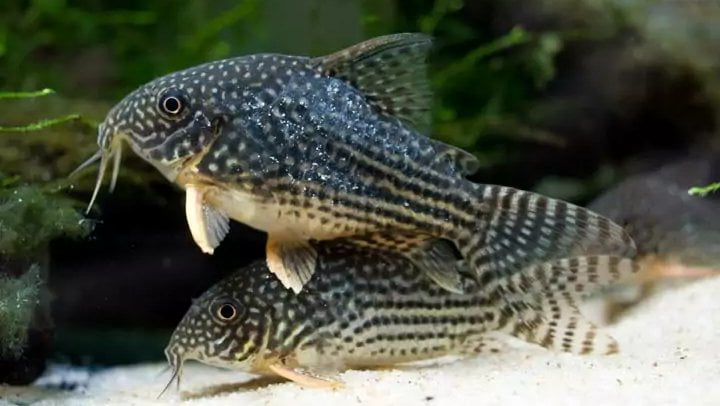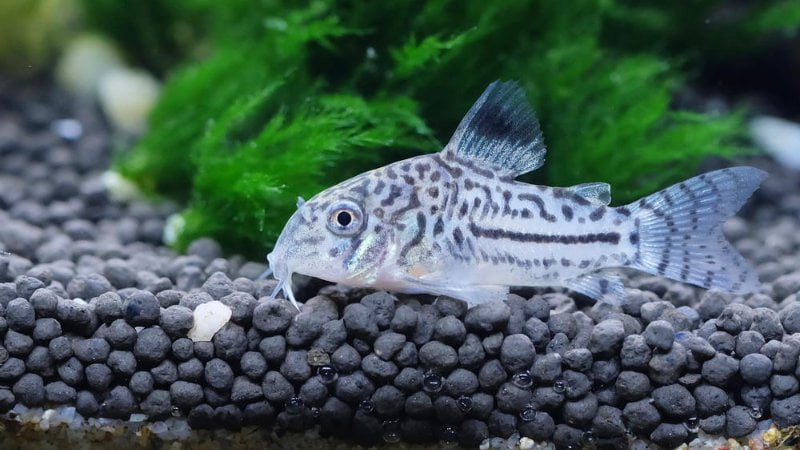This seems a complex for aquarists that have the first-time breeding and caring for cory catfish. Is a Cory Catfish Planted Tank suitable?
There are plenty of tanks for you to choose from that I can list immediately, such as a reef tank that includes corals, sand, rubble, and macroalgae to provide hiding places for the fish. An artificial tank with fake plants is extremely convenient for cleaning and also doesn’t affect oxygen levels.
How about a planted tank? Why should you choose this one but not these two?
Do Cory Catfish Enjoy Planted Tank?
The fact that many experienced hobbyists confirm that cory catfish do their best in a planted tank. Though sometimes they root up the plant, no big problems happen then. The cories enjoy swimming through plants. They don’t normally dig in the sense of actually digging holes, but the larger ones can get energetic enough at sifting through the upper layers of the substrate that shallow-rooted plants can come up. I prefer the time when they are foraging for food. They swim gracefully and absolutely love to hang out together.
Doesn’t it show that they seem to have more power and be brighter in an environment with plants? Not only Cory Catfish, but all creatures also tend to be happier when living in their natural habitat. The result that you keep a group of cories with suitable live plants surely makes you even enjoy the aquarium hobby more and more when observing how lovely they are.
Benefits Of Cory Catfish Planted Tank

Three benefits
Each type of tank has its positive and negative aspects, but choosing a planted tank is having most of the benefits.
First, a planted tank offers many advantages which cannot be duplicated by artificial plants or reef tanks, including providing a more natural habitat for cory catfish.
Second, corries become most healthy in an environment with high oxygen levels. During daylight hours, live plants take in carbon dioxide and give off oxygen, thus contributing to a healthy habitat. Please keep in mind that the process reverses, which is the cause of oxygen reduction. In this case, you just need to maintain the light, which is as natural as you can for both plants and corries. An airstone is also needed.
A planted tank also supplies a good harbor for beneficial bacteria, a key part of biological filtration. In specific, these beneficial bacteria can break down the nitrites into nitrates, which are not as toxic, and prevent corries from nitrates poisoning. By reducing nitrates, plants can inhibit algae growth.
Note
As I mentioned before, live plants do respiration at night, which means the corries have to deal with lacking oxygen. It may indicate a low oxygen level at night if fish are seen hanging close to the surface and gasping for air. In such cases, an airstone may need to be turned on.
If decaying plants aren’t removed quickly enough, they can produce too much waste, which can harm fish. Additionally, live plants may carry harmful pests such as snails and parasites that may cause disease. Again, maintaining your cleaning tank schedule is the most important thing.
Video: Planting The Emerald Green Cory Cats Tank
FAQs
Do corydoras like carpet plants?
Corydoras enjoy carpet plants. They aren’t destructive. I believe they would make a great cleaning crew, and it would be even better if you kept small species. To prevent carpet plants from growing up the corydoras if they are not well anchored in the substrate, please place them solidly.
Do corydoras eat algae?
Corydoras don’t eat algae. Cory catfish won’t eat algae that grow on the tank walls or substrate despite being bottom feeders. In general, corydoras shy away from eating algae, though occasionally they eat sinking algae wafers.
Do corys clean tanks?
Cory catfish are excellent cleaners since they are small bottom-feeders. It will clean up after messier fish that feed at the surface and mid-level of the tank, scavenging the leftovers that have sunk to the bottom.
Conclusion
The facts and benefits show that a planted tank is truly an ideal choice for cory catfish, but don’t forget these two notes: oxygen level reduction at night and harmful waste by decaying plants. These problems can be prevented if you have your preparation.
And then, what is our recommendation of plants for corries? Please check out relative articles.

Annette M. Chaney is an experienced marine biologist with over 20 years of experience as an aquarist and fishkeeper. She started her first aquarium at a young age, filling it with frogs and goldfish obtained from the ten-cent pet store.
Annette grew up caring for and breeding African Cichlids, which led to a hobby in high school that doubled as a profitable means. Attending Reed College gave her time to solidify herself as an accomplished aquarium caretaker with an eye for sales. After that, from 2009 – 2013, she studied at Roger Williams University – one of the most prestigious universities for Aquaculture and Aquarium in USA. She is the founder of AquariumCircle since 2010.
